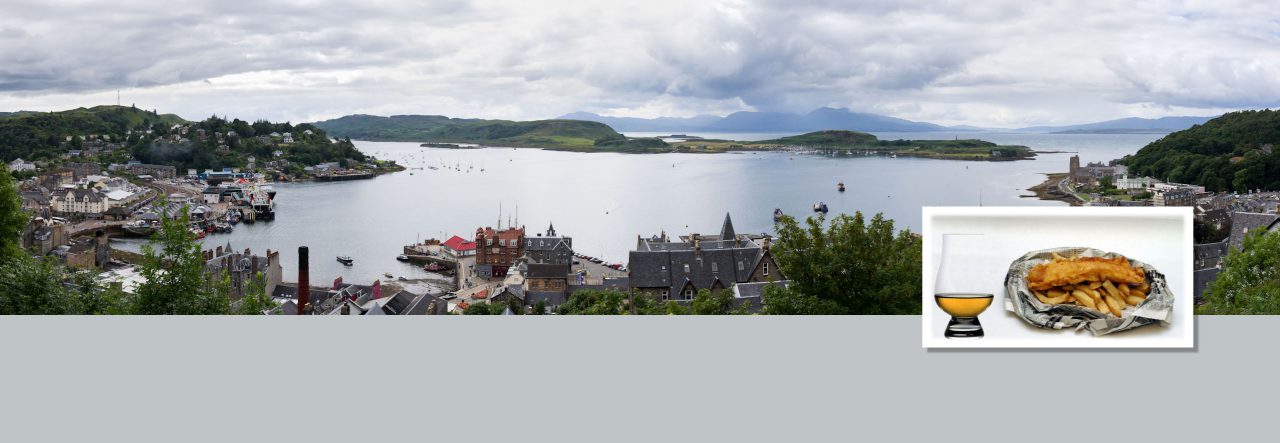In which we just have one tour booked, an informal “build your own tasting” sort of afternoon planned, and end up with a curated tasting that may be impossible to beat…
We just have the one tour booked today, at Bowmore, but we plan to hit Bruichladdich and buy a few drams at their tasting bar. We couldn’t quite fit an available tour in to the logistical jjgsaw that is our itinerary, but we wanted to hit all 9 Islay distilleries on this trip, so “self guided” it is.
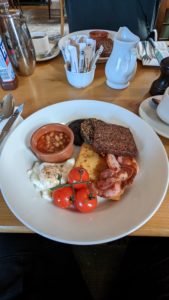
Breakfast at the Bridgend Hotel was my usual – full Scottish breakfast. The Bridgend version is beans, one slice (real) bacon, one slice slicing sausage, tomatoes, beans, Stornoway black pudding (arguably the best), haggis, and a poached egg. Oh, and a toasted tattie scone. I know, I know, it sounds like a lot of food. That’s because it IS a lot of food. But it isn’t uber unhealthy, it is full of protein, and if you’re not planning lunch, you’d better believe that this will get you through the day. And, perhaps more relevantly, the drams.
Since we’d slept in a little, it was pretty much straight to Bowmore following breakfast. The long, arduous, three mile trip got us there a little early, so we putzed about the shop until our guide, Meghan, collected us for the basic tour.

Bowmore has the singular honor of being the oldest distillery on Islay, having started its life back in 1779. In fact, the only distillery in Scotland that’s older is Glenturret. You can tell that the town grew up around it; it even moved on to their campus a little, when the disitllery gifted one of their buildings (no longer in use) to the town and it was turned into a leisure center.
They’re a surprising compact distillery, which is necessary when a town has grown up around you and basically locked you into place. For this reason, they have, for example, maltings on three stories of the same building, If you cannae build oot, ye’ve got tae build up! Talking of malting floors…
Bowmore is one of the three Islay distilleries that still has their own malting floor, along with Kilchoman and Laphroaig. Only four more distilleries on the mainland maintain malting floors; the rest rely on commercial malting facilities both on the island and mainland. The island can’t provide enough barley for their production volume, so they purchase most of their barley from 16 dedicated farms on the mainland and malt 25% of their own. Malting at Bowmore involves 26 hours of steeping, after which the barley is dumped out of chariots and spread around the malting floor using malt shovels – all 14 tons of it. It’s then left unmolested for 24 hours, after which it’s turned, and then checked and turned every 4 hours for the next 5-7 days (depending on temperatures, time of year, etc.). They try to keep the malt barns at a constant temperature, but there’s going to be some fluctuation in these old buildings.
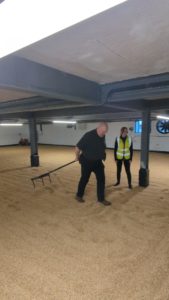
The resulting “green malt” is then sent to the kiln, where it is peat smoked to 25-30ppm over the course of 10 hours, then dried for 34 hours. They lose about 2 tons (from the original 14) to moisture loss, not as much as perhaps I would have thought. Fun fact: the iconic pagoda style roof above the kiln is flat, to prevent too much of the smoke escaping; in fact, it’s drawn back down by fans to make sure they get the most out of each burning. They burn about 1 ton of peat at a time, and somewhat unusually use mostly top peat, which is much wetter. There are three kiln runs a week, so about 3 tons of peat consumed every 7 days. Another fun fact: they use a heat exchange from the stills to dry the kiln (and heat the visitor center, and the swimming pool in the leisure center).
The smoked and malted barley is then mixed with mainland malt at a ratio of 3 mainland parts to 1 island part, and is then left in malt bins for 2 days so that the grains can get to know each other a little better.
Next, the mill. Standard stuff. Porteus mill, which was build in 1866 and still runs 156 years later. The same gent who maintains Vickers Boby mills also maintains Porteus mills, and his name and contact information is similarly on a plaque mounted to the mill. I swear, he has the single most exclusive job in the country. The mill processes 8 tons at a time, in 20kg batches, because the UK can’t decide between metric and imperial.
OK, you know what’s next: mash tun. 27,000 liters of water at 63.5C, 13,000 liters at 85C, giving 40,000 liters of wort. The last run is 27,000 liters at 100C to create the sparge water that will be used for the next first run. Oh, and the mash tun is coal fire heated.
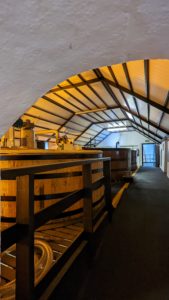
Washbacks are Douglas Fir aka Oregon Pine. They tried stainless steel some years ago, but didn’t like the results. Even though wooden washbacks are cleaned thoroughly between uses, there’s still some small residual “stuff” (techinical term) that imparts just enough “something extra” (sorry for all the jargon) to each run that they noticed the difference. So they went back to wooden. Two different yeasts are used, combined to 100kg which is added to the 40,000 liters. It takes about 2 hours for the reaction to begin, fermentation happens for 48 hours, then it just hangs out getting tasty for another 12 hours. 62 hours later, it’s ready to go.
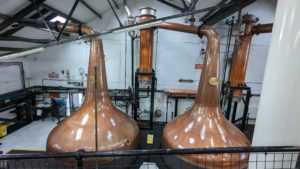
The still house is facinating. Yes, I know, I find them all fascinating, but get this. The wash is split across two identical wash stills rather than one large one (or multiple runs). The resulting low wines are then combined in the low wines tank. These are then split across two NOT IDENTICAL spirit stills. One has a slightly shorter bowl, marginally longer neck, and steeper up angle on the lyne arm. The other has a taller bowl, with mostly consistent angle on the shoulders, a shorter neck, and a much lower but still upward angle on the lyne arm. These two spirit stills will produce different new make sprits – the difference will likely be subtle, but it will be there. The runs are then combined, and /that/ becomes the Bowmore new make spirit. Fascinating. And fascinating because, as I thought once (ok, or twice… fine, lots!) about my own dream distillery, I had a similar idea. I wanted two very different types of still, to try to make two different new makes, and then realized that a third version would be possible by combining the two. Some day, I want to ask if it’s possible to sample the two runs, but I was so caught up in things today, I forgot to ask.
OK, numbers. Low wines come off at around 22-24% (or, more likely, lower, but the combination of wash still run and heads and tails of spirit runs are 22-24%). The Heart is captured from 74-62%, averaging around 68.8% when done, which is then watered down to 63.5% for maturation. All told, they get about 4,800 liters of spirit from the initial 40,000 liters of wort.

Bowmore Warehouse No. 1 is the oldest maturation building in the world, which is kinda cool. Literally and figuratively. It sits on the edge of Loch Indall, so it ain’t warm. It’s also remarkably well sealed, so much so that their angels’ share is only about 0.5%, rather than the 2% that most Scottish distilleries experience. I bet that makes the accountants happy. This building was also the site of the entire distillery originally, so things have grown a wee bittie since then. Some fun facts include… There are three Mizunura casks aging in there. These Japanese oak casks are very rare, and very difficult to work with. To have any effect on the spirit, the maturation timeline has to be extended. Don’t expect to see this whisky for a while. And don’t expect to be able to afford it either. There are 3,000 casks maturing in the warehouse. The rest are in warehouses on Laphroaig’s property; Bowmore and Laphroiag are siblings, following the “marriage” of their two parent companies, Beam and Suntory.
One other fun fact, pertinent in particular given recent events. Her Majesty Queen Elizabeth II (or Lizzy 2, as I liked to call her for some reason that would probably still get me sent to the stockades) was a huge fan of Bowmore (she was something of a whisky fan in general). She was therefore gifted three casks which are now empty, but “The Queen’s Casks” remain on display in the warehouse. When they were emptied and bottled, the bottles were sold for charity, but not before she had gifted every Bowmore employee their own bottle. Lizzy 2 rocked.

We then headed up to their tasting bar for, well, our tasting. Three drams:
- 12 year core range, 40%
- 15 year core range, 43%
- 15 year 2019 Feis Ile, 51.7%
Tour was done, interesting drams still existed in the bar, so we of course bought ourself the “Distillery Exclusive Selection” to enjoy by the windows overlooking the loch.
- Feis Ile 2022 15 year, 54.7%
- Feis Ile 2020 18 year, 51.2%
- Distiller’s Anthology 25 year, 50.2%
Sorted.
————
As designated driver, I needed to walk around a bit before getting behind the wheel. Felt fine, but it would be stupid to jump straight into the car. Much like jumping into traffic, jumping into a locked car is also guaranteed to get people’s attention in that “not good” sort of way. So we walked down to the edge of the water to get some photies, and then to the Islay Whisky shop for a wee nosy. Learned about Finlaggan, an independent bottling that gets rave reviews from the locals. Didn’t snag one, but the Feis Ile bottlings were tempting, not least of all because they were affordable at about half the price of a distillery Feis Ile expression.
I also snagged some fruit cake slices, because nosing and drinking heavily sherried whiskies all morning got me a hankering for fruit cake. Real fruit cake, not the preserved-for-all-time-candied-fruit-held-together-with-minimal-flour that passes for fruit cake in the US.
Next stop was a quick diversion so that I could try to track down an artist we saw on our last visit to Islay in 2018. She had paintings of each distillery, and a large print with all of them that I studiously didn’t purchase in 2018 but kinda wanted to. Still, next visit. Well, it is the next visit, and she ain’t there any more. Bugger. I’ll be spending some quality time on the interwebs and auction sites, apparently.
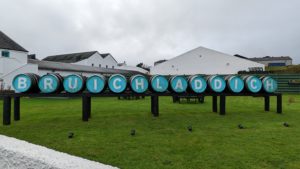
Alrighty then, that just leaves our self-guided tour. We head off to Bruichladdich and, well, arrive a very short time later. It’s a small island, what can I say. When we arrived at the visitor center, I chanced our luck a little and asked if there were any spaces on any remaining tours and got the answer I expected: nope. But a very apologetic and friendly nope, and we didn’t mind anyway. We wandered aboot the shop for a bit then approached the tasting bar, all ready to purchase some drams. Yeah, no, all samples are free, which made things easier. We’ll grab ourselves 2 or 3 samples of interesting, non-mainstream things, and we’ll be good.
It has apparentlty been a busy week at Bruichladdich, and the staff were all exhausted. But that didn’t affect their attentiveness to us, or the rather large and not-rambunctuous but not-sedate Swedish tour group, who were absolutely having a good time and were quite well behaved. Just very “present” in the visitor center.

Our host was Roxanna, and she was delightful. She’s was also extremely knowledgeable of the entire Bruichladdich range, which I suspect predates her. She’s also “one of us” – she plays the auction houses and, during the pandemic, somewhat accidentally ended up with over 50 bottles of Kilchoman. Yeah, we liked her a lot. And so we just hung out and chatted.
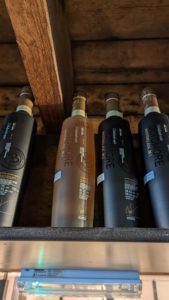
Of particular interest to me is the Octomore range, their stupidly heavily peated range. Their releases typically sit around 167ppm, though they’ve gone as high as 309ppm. Just once. Release 8.3. And that’s the one I’ve been hunting for for years. So I naturally asked about it, and wasn’t surprised to learn that they didn’t have any available. In fact, they blew through this year’s realease (the 13’s) in no time and had to tap an archival reserve of 11.1 to have any Octomore on sale in the shop.
And so we continued to chat and hang out. The Swedes popped back through a couple of times (they were on consecutive tours and tastings), enjoying themselves and spending gobs of money. One gent snagged three DIY bottlings, an Octomore, a Hebridean Strength Botanist Gin, and a cycling shirt, which easily took him to over six hundred quid. He came back later for more. The others were dropping less, but still hundreds each. We were not. So when they drifted through, we disengaged Roxanna so that she and her colleagues could manage the crowd, which they did magnificently and in great humor. Then, when things calmed down, Roxanna would check in with us, and offer us something new to try. It was a wonderful couple of hours, and far more than we had ever imagined for what was really just supposed to be a drive-by.
I can’t stress enough that if you visit a distillery, you should engage with the staff, because they’re generally knowledgeable, personable, and likely passionate about their product. And I’m not just talking about the managers, the stillmen, etc. I’m talking tour guides, shop staff (often the same people), etc. I mean, Roxanna for all the world just looked like one of the lassies behind the tills. And she was behind the tills. She was also a font of information, a lover of whisky, and just easy and fun to talk with. It would have been impossible not to enjoy our exchanges. But I see so many people rush in, take the tour, take their photos, and rush out. Or take their dram, sniff it and drink it because that’s what you do, don’t really respond to prompts from the hosts, and then just leave without a word. Drives me nuts. I’m sure the hosts are quite used to it, but I also know that they could add so much more to the distillery experience if you let them. So I always engage. I mean, it helps that I always have questions, so there is that. But even if I don’t have some geeky thing to ask, I’ll approach the exchange differently. Instead of “I’d like my one free dram please” try “What would you recommend?”. Instead of “What would you recommend?” try “What’s your favourite?” or “What’s an interesting dram that I couldn’t find elsewhere?”. Or even just “How are /you/ doing today?” As someone who’s worked customer service in some form or another for basically his whole professional life, I can tell you that last question is huge. Makes you feel human. And I feel that treating people who are helping me as humans is the least i can do. And dear gods, if they’re pouring me whisky… they’re approaching sainthood 🙂
And that’s why we got along so well with Roxanna. And that’s why she reached under the counter at one point and very very discretely poured us a sample of something they’d sold out of very fast when it was released earlier this year, that made my little heart go pitter patter. And that’s also why she disappeared for a while during a busy spell (we were wandering again), reappeared, slipped through the crowd to find me, apologized* because she thought she’d seen Octomore 8.3 somewhere on site but couldn’t find it, and palmed me a sample bottle of a very old and rare Bruichladdich for John and I to enjoy later tonight.
We love Roxanna.
*/quite/ unnnecessarily as I had no idea she’d been hunting.
We have been treated extraordinarily well this trip already, and we’re just this couple of guys, you know? But I think it’s because we play nice with others, and others tend to appreciate that. And we appreciate them. It’s a wonderfully uplifting circle of life thing.
By the end of our visit, this was our completely free but utterly wonderful, somewhat curated flight:
- Bruichladdich Organic 2011,
- Bruichladdich Bere Barey 2012
- Bruichladdich Valinch 62 “Rona”, 62.7%
- BC:06 2010, 63.4%
- Botanist Hebridean Strength, 51.5%
- Octomore 11.1, 139.6ppm, 59.4%
- Octomore 13.3 (yeah, one they’d held back for special occasions)
- Old and rare expression that ended an incredible day
I walked out with a bottle of 62 “Rona”, because I simply couldn’t leave empty handed (but couldn’t really afford everything I wanted)
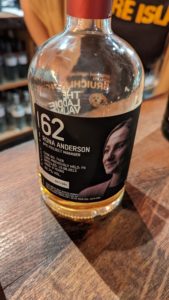
OK, so where the hell do you for from there? We had dinner reservations at Ballygrant which was much quieter than we expected for a Saturday night (everyone seemed to be at Bridgend, so we were happy to not be). Euan treated us well, as usual. Dinner was incredible, and we wrapped up some drams that we’d been looking to wrap up from their insane menu. John and I have now both tried the entire Laphroaig Cairdeas series (over the course of several years), and John has sealed his fate as a Kilchomanaholic. Which we all thoroughly endorse.
Back at the hotel, we finished the night with the freebie Bowmore No. 1 minature that I completely forgot to mention earlier in the post. Then we finished the day with dram number 20 “Roxanna’s Dram”.
Dram, that was good.
